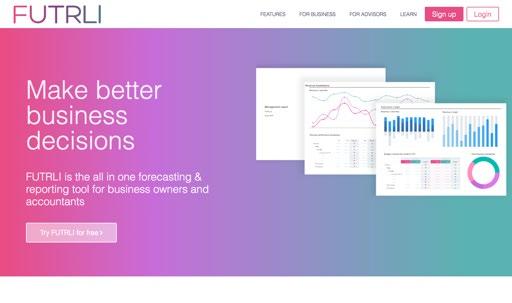
5 minute read
The argument for value pricing
The success of a business often hinges on revenue growth, so getting your billing strategy right is crucial. Research from PwC has found that a 1% price increase can improve profits by 11%, with pricing alone often impacting EBITDA more than all other sales and marketing strategies...
@AutoEntry_OCREX
Brendan Woods, founder and CEO, AutoEntry
Originally a software developer in the hedgefund space, Brendan quit his job and started the company to automate data entry for accountants and bookkeepers.
AutoEntry, automates data entry of purchase and sales invoices, receipts, bank statements and more, providing significant time and cost savings. A trusted supplier to over 2,000 accounting firms, providing them with intelligent solutions for data entry automation.
Despite many accounting
professionals still charging by the hour, many more firms are now adopting value pricing in order to better connect with customers and gain a competitive edge in the market. It’s a compelling argument and here are a few of the factors convincing businesses to make the switch.
Economics
Ron Baker, CPA and advocate of value pricing, once commented, “Don’t ask your client ‘What do you need?’ Ask ‘What are you trying to achieve?’”. The learning here is for accountants to reconsider their pricing strategies from the client’s perspective. And understanding that at the core of any transaction, customers will only part with their money if they believe the value they’ll receive for the service is more than the price they’ll pay.
Hourly billing is at odds with this principle, as it misaligns the interests of the accountant to those of the client. The customer will typically want a job completed as quickly as possible, whereas the priority of the accounting firm will be to bill for longer hours. Valuebased pricing is a more effective alternative, as it identifies a client’s growth targets and sets a price based on the perceived value of the work needed to achieve these targets.
Revenue
Value in itself is subjective. So accountants will need to tailor their proposal to each customer, and be prepared to negotiate. A good place to start is by discussing the extent of work needed to undertake a given project and the methods that can be taken to achieve the desired result, according to cost.
This is where the concept of ‘goldilocks pricing’ can be applied. This effective selling technique taps into buyer psychology and offers products or bundles of services at different price points. Analysts have found that on average, most consumers will gravitate towards the middle option, so this allows practitioners to craft a middle or ‘recommended’ package to suit the majority, whilst cross selling other products as part of the transaction.
As fees are agreed in advance, there will be no surprises or quibbles regarding the bill - given that the services are carried out to the standards expected. So as well as positioning themselves as a trusted business advisor, firms can better predict their own revenues in advance. And by selling services based on value rather than cost, management will also gain insight into the worth of their existing services, and those which are the most lucrative.
Customer Loyalty
Value pricing positively impacts client satisfaction and retention, by fostering relationships built on transparency and trust. Customers will be able to build a clearer picture of the services (rather than time) they’re paying for and may also feel more comfortable to pick up the phone during the process, without feeling like it will add more expense to the bill. Value pricing will also help accounting firms differentiate themselves in the marketplace and encourage new prospects to choose their services based on more than price alone.
Digital Working
Traditional, hourly billing, is at odds with efficiency. As adoption of cloud-based accounting and automation increases, accountants will turnaround projects faster. And whilst clients will appreciate this speed of service, it will force firms to bill fewer hours for the same amount of work.
Many accounting and bookkeeping firms now have a digital-first strategy, leveraging a range of apps and automated tools for inventory management, CRM, invoicing and more. By using these types of solutions, accountants will be able to reduce administrative burdens and ultimately create the capacity to take on more new clients. Value
pricing compliments this type of digital working, as firms can continue to leverage automation in the back office, without necessarily reducing rates.
And those forward-thinking firms switching to value pricing, are typically those who are also eliminating outdated and costly processes, such as manual data entry. They are doing this by adopting solutions such as AutoEntry, a Xero add-on, as part of their digital infrastructure.
AutoEntry works by capturing and analysing scanned and For instance, AutoEntry captures posting duplicate invoices in Xero.
photographed receipts, purchase
statements, and more, automating data entry into Xero. Its flexible pricing and uniquely innovative features empower users by making every working day more efficient. tax summaries by default and if requested, full line item details including description, quantity and unit price. AutoEntry also remembers how you categorise your expenses such as the relevant supplier account, nominal account and tax code without ever creating duplicate supplier accounts or and sales invoices, bank and card
32
AutoEntry even matches invoices to purchase orders.
In conclusion
Ron Baker commented, “One of the biggest stumbling blocks is that the accountancy profession has a low tolerance for ambiguity - but value is a feeling, not a number”.
Indeed, for a profession rooted in tradition and certainty, it might take a while for some to adjust to this seemingly more intangible method of operating. However, it will increasingly be the only option for those firms looking to capitalise on innovation in order to bolster growth and better serve their customers, by having a clearer idea
of what value means to them.
The all in one advisory platform for accountants & bookkepers

futrli.com











